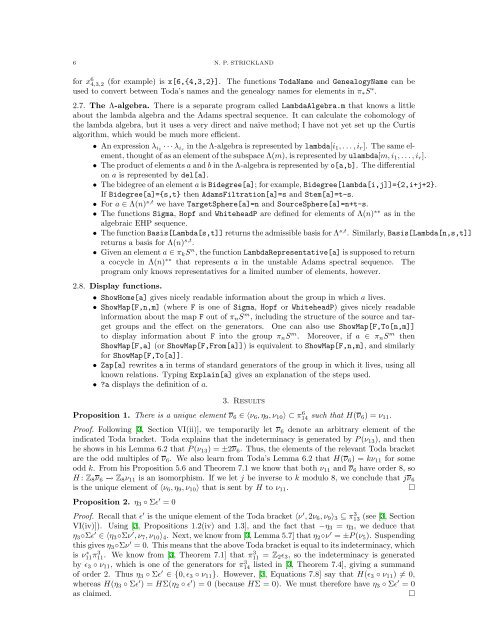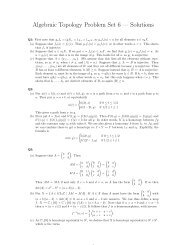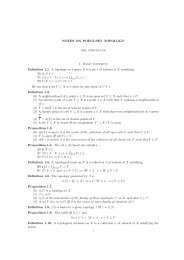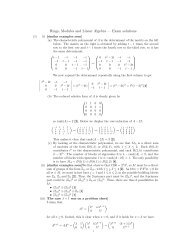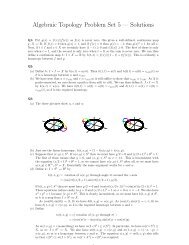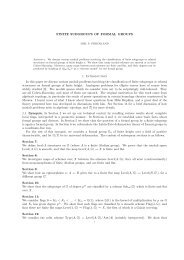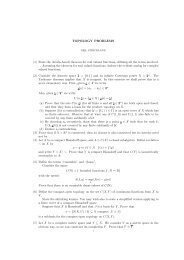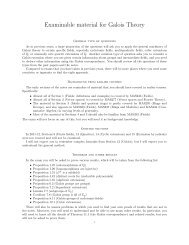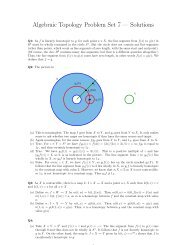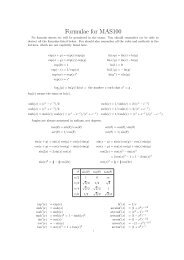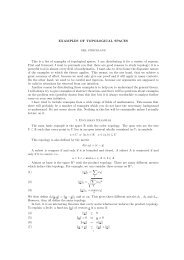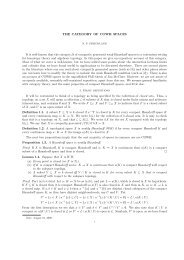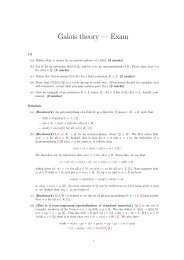A MATHEMATICA REPRESENTATION OF SOME ... - Neil Strickland
A MATHEMATICA REPRESENTATION OF SOME ... - Neil Strickland
A MATHEMATICA REPRESENTATION OF SOME ... - Neil Strickland
You also want an ePaper? Increase the reach of your titles
YUMPU automatically turns print PDFs into web optimized ePapers that Google loves.
6 N. P. STRICKLANDfor x 6 4,3,2 (for example) is x[6,{4,3,2}]. The functions TodaName and GenealogyName can beused to convert between Toda’s names and the genealogy names for elements in π ∗ S ∗ .2.7. The Λ-algebra. There is a separate program called LambdaAlgebra.m that knows a littleabout the lambda algebra and the Adams spectral sequence. It can calculate the cohomology ofthe lambda algebra, but it uses a very direct and naive method; I have not yet set up the Curtisalgorithm, which would be much more efficient.• An expression λ i1 · · · λ ir in the Λ-algebra is represented by lambda[i 1 , . . . , i r ]. The same element,thought of as an element of the subspace Λ(m), is represented by ulambda[m, i 1 , . . . , i r ].• The product of elements a and b in the Λ-algebra is represented by o[a,b]. The differentialon a is represented by del[a].• The bidegree of an element a is Bidegree[a]; for example, Bidegree[lambda[i,j]]={2,i+j+2}.If Bidegree[a]={s,t} then AdamsFiltration[a]=s and Stem[a]=t-s.• For a ∈ Λ(n) s,t we have TargetSphere[a]=n and SourceSphere[a]=n+t-s.• The functions Sigma, Hopf and WhiteheadP are defined for elements of Λ(n) ∗∗ as in thealgebraic EHP sequence.• The function Basis[Lambda[s,t]] returns the admissible basis for Λ s,t . Similarly, Basis[Lambda[n,s,t]]returns a basis for Λ(n) s,t .• Given an element a ∈ π k S n , the function LambdaRepresentative[a] is supposed to returna cocycle in Λ(n) ∗∗ that represents a in the unstable Adams spectral sequence. Theprogram only knows representatives for a limited number of elements, however.2.8. Display functions.• ShowHome[a] gives nicely readable information about the group in which a lives.• ShowMap[F,n,m] (where F is one of Sigma, Hopf or WhiteheadP) gives nicely readableinformation about the map F out of π n S m , including the structure of the source and targetgroups and the effect on the generators. One can also use ShowMap[F,To[n,m]]to display information about F into the group π n S m . Moreover, if a ∈ π n S m thenShowMap[F,a] (or ShowMap[F,From[a]]) is equivalent to ShowMap[F,n,m], and similarlyfor ShowMap[F,To[a]].• Zap[a] rewrites a in terms of standard generators of the group in which it lives, using allknown relations. Typing Explain[a] gives an explanation of the steps used.• ?a displays the definition of a.3. ResultsProposition 1. There is a unique element ν 6 ∈ 〈ν 6 , η 9 , ν 10 〉 ⊂ π 6 14 such that H(ν 6 ) = ν 11 .Proof. Following [3, Section VI(ii)], we temporarily let ν 6 denote an arbitrary element of theindicated Toda bracket. Toda explains that the indeterminacy is generated by P (ν 13 ), and thenhe shows in his Lemma 6.2 that P (ν 13 ) = ±2ν 6 . Thus, the elements of the relevant Toda bracketare the odd multiples of ν 6 . We also learn from Toda’s Lemma 6.2 that H(ν 6 ) = kν 11 for someodd k. From his Proposition 5.6 and Theorem 7.1 we know that both ν 11 and ν 6 have order 8, soH : Z 8 ν 6 −→ Z 8 ν 11 is an isomorphism. If we let j be inverse to k modulo 8, we conclude that jν 6is the unique element of 〈ν 6 , η 9 , ν 10 〉 that is sent by H to ν 11 .□Proposition 2. η 3 ◦ Σɛ ′ = 0Proof. Recall that ɛ ′ is the unique element of the Toda bracket 〈ν ′ , 2ν 6 , ν 9 〉 3 ⊆ π13 3 (see [3, SectionVI(iv)]). Using [3, Propositions 1.2(iv) and 1.3], and the fact that −η 3 = η 3 , we deduce thatη 3 ◦Σɛ ′ ∈ 〈η 3 ◦Σν ′ , ν 7 , ν 10 〉 4 . Next, we know from [3, Lemma 5.7] that η 2 ◦ν ′ = ±P (ν 5 ). Suspendingthis gives η 3 ◦Σν ′ = 0. This means that the above Toda bracket is equal to its indeterminacy, whichis ν11π ∗ 11. 3 We know from [3, Theorem 7.1] that π11 3 = Z 2 ɛ 3 , so the indeterminacy is generatedby ɛ 3 ◦ ν 11 , which is one of the generators for π14 3 listed in [3, Theorem 7.4], giving a summandof order 2. Thus η 3 ◦ Σɛ ′ ∈ {0, ɛ 3 ◦ ν 11 }. However, [3, Equations 7.8] say that H(ɛ 3 ◦ ν 11 ) ≠ 0,whereas H(η 3 ◦ Σɛ ′ ) = HΣ(η 2 ◦ ɛ ′ ) = 0 (because HΣ = 0). We must therefore have η 3 ◦ Σɛ ′ = 0as claimed.□


